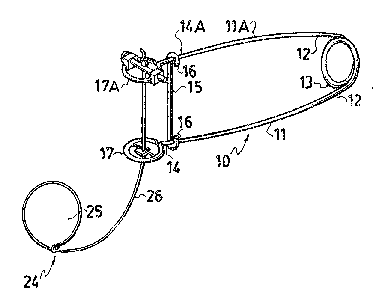Une partie des informations de ce site Web a été fournie par des sources externes. Le gouvernement du Canada n'assume aucune responsabilité concernant la précision, l'actualité ou la fiabilité des informations fournies par les sources externes. Les utilisateurs qui désirent employer cette information devraient consulter directement la source des informations. Le contenu fourni par les sources externes n'est pas assujetti aux exigences sur les langues officielles, la protection des renseignements personnels et l'accessibilité.
L'apparition de différences dans le texte et l'image des Revendications et de l'Abrégé dépend du moment auquel le document est publié. Les textes des Revendications et de l'Abrégé sont affichés :
| (12) Brevet: | (11) CA 1268943 |
|---|---|
| (21) Numéro de la demande: | 1268943 |
| (54) Titre français: | PIEGE MECANIQUE |
| (54) Titre anglais: | POWER SNARE |
| Statut: | Durée expirée - après l'octroi |
| (51) Classification internationale des brevets (CIB): |
|
|---|---|
| (72) Inventeurs : |
|
| (73) Titulaires : |
|
| (71) Demandeurs : | |
| (74) Agent: | BATTISON WILLIAMS DUPUIS |
| (74) Co-agent: | |
| (45) Délivré: | 1990-05-15 |
| (22) Date de dépôt: | 1986-06-27 |
| Licence disponible: | Oui |
| Cédé au domaine public: | S.O. |
| (25) Langue des documents déposés: | Anglais |
| Traité de coopération en matière de brevets (PCT): | Non |
|---|
| (30) Données de priorité de la demande: | S.O. |
|---|
- 12 -
POWER SNARE
ABSTRACT OF THE DISCLOSURE
Animal traps are usually difficult to sterilize
in order to remove human odour therefrom and difficult to
hide when setting and often contain moving parts, tubes,
pins and the like. The present device consists of a pair
of spring arms made of heavy wire with a hairpin spring
at the junction thereof. Eye loops are formed one on
each distal end of the arms and one of these has a
slotted semi-circular plate welded otherwise secured into
the base of the eye. A freely running snare loop is
provided on one end of a standing part, in which part
extends through the slot in the disk or plate and through
a cotter pin assembly spanning the other eye and termi-
nates with a ferrule outboard of the other eye. A
trigger block is secured to the standing part inboard of
the slotted disk when the trap is set with the two arms
close together and being urged apart by the spring. The
snare loop is adjustable to catch the shoulders of the
animal, and the movement thereof disengages the trigger
block from the slotted disk and allows the arms to spring
apart tightening the snare loop and striking the animal a
heavy blow with the eye of the one arm.
Note : Les revendications sont présentées dans la langue officielle dans laquelle elles ont été soumises.
Note : Les descriptions sont présentées dans la langue officielle dans laquelle elles ont été soumises.

2024-08-01 : Dans le cadre de la transition vers les Brevets de nouvelle génération (BNG), la base de données sur les brevets canadiens (BDBC) contient désormais un Historique d'événement plus détaillé, qui reproduit le Journal des événements de notre nouvelle solution interne.
Veuillez noter que les événements débutant par « Inactive : » se réfèrent à des événements qui ne sont plus utilisés dans notre nouvelle solution interne.
Pour une meilleure compréhension de l'état de la demande ou brevet qui figure sur cette page, la rubrique Mise en garde , et les descriptions de Brevet , Historique d'événement , Taxes périodiques et Historique des paiements devraient être consultées.
| Description | Date |
|---|---|
| Inactive : Périmé (brevet sous l'ancienne loi) date de péremption possible la plus tardive | 2007-05-15 |
| Inactive : CIB de MCD | 2006-03-11 |
| Accordé par délivrance | 1990-05-15 |
Il n'y a pas d'historique d'abandonnement
| Type de taxes | Anniversaire | Échéance | Date payée |
|---|---|---|---|
| TM (catégorie 1, 8e anniv.) - petite | 1998-05-15 | 1998-05-13 | |
| TM (catégorie 1, 9e anniv.) - petite | 1999-05-17 | 1999-05-06 | |
| TM (catégorie 1, 10e anniv.) - petite | 2000-05-15 | 2000-05-15 | |
| TM (catégorie 1, 11e anniv.) - petite | 2001-05-15 | 2001-03-21 | |
| TM (catégorie 1, 12e anniv.) - petite | 2002-05-15 | 2002-05-01 | |
| TM (catégorie 1, 13e anniv.) - petite | 2003-05-15 | 2003-05-06 | |
| TM (catégorie 1, 14e anniv.) - petite | 2004-05-17 | 2004-05-06 | |
| TM (catégorie 1, 15e anniv.) - petite | 2005-05-16 | 2005-05-05 | |
| TM (catégorie 1, 16e anniv.) - petite | 2006-05-15 | 2006-03-21 |
Les titulaires actuels et antérieures au dossier sont affichés en ordre alphabétique.
| Titulaires actuels au dossier |
|---|
| BRUCE H. BERTRAM |
| Titulaires antérieures au dossier |
|---|
| S.O. |